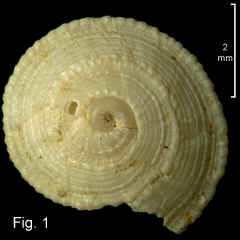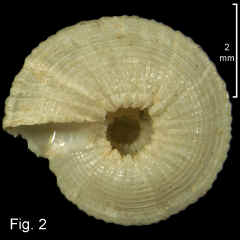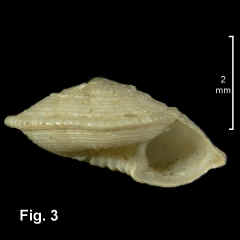|
|
ARCHITECTONICIDAE |
|
|
|
Solatisonax atkinsoni (E.A. Smith, 1891) Description: Shell small, spire moderately low, convex in outline. Teleoconch of up to 3 whorls, surface irregular. Whorls straight-sided, sculptured with spiral cords; a moderately strong, weakly nodulose spiral cord at top, 3 or 4 weaker cords below, another moderate strength cord further below, and at lower margin of whorl, a strong, irregularly nodulose cord forming a keel on last whorl. Umbilicus open, margin heavily but coarsely toothed; base moderately convex, with about 15 spiral threads, becoming progressively finer from umbilicus to periphery, and strong radial folds. Colour white or cream. Size: Up to 8 mm in diameter. Distribution: Known from Sydney, NSW, southwards and around southern Australia to Great Australian Bight, including eastern Tasmania. Habitat: Subtidal, 70–750 m. Very uncommon. Remarks: The holotype is from Challenger station 164B, from 410 fathoms (750 m) off Sydney. It was suggested (Hedley, 1918, p. M3; Iredale & McMichael, 1962, p. 4) that an error had been made, and the specimens from Station 164B were from the Atlantic Ocean, as they were unfamiliar to Australian workers at the time. But it is now recognised (Darragh, 1969, p. 82 and this work for Cylindriscala distincta (E.A. Smith, 1891) and Microvoluta miranda (E.A. Smith, 1891)) that the locality of 750 m off Sydney was indeed correct. Bieler (1993), on the assumption that the type locality was in the Atlantic, suggested that the name for the NSW shells should be S. supraradiata (Martens, 1904). Under that name he illustrates specimens which are a good match for the Australian shells. Thus Solarium supraradiatum Martens, 1904 is a synonym of Solarium atkinsoni E.A. Smith, 1891 (NEW SYNONYM). Figs. 1–3: Bass Strait, S. of Cape Everard (C.210053). |
|


